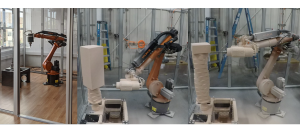
A building’s shape is one of the earliest design decisions that has an impact on its structural system, performance, life-cycle costs and architectural appeal. The current design of buildings is based on blueprints that have historically provided good performance for structural loads, performance under extreme loads and life-cycle costs. Brian Phillips, Ph.D., a civil engineering associate professor in the Engineering School of Sustainable Infrastructure & Environment within the Herbert Wertheim College of Engineering, received a National Science Foundation grant to provide innovative solutions to optimize buildings and improve current practices.
With support from this $530,000 grant, Dr. Phillips will pioneer a new framework that will benefit all aspects of building design and construction — including architects, engineers and building owners. He states that his research will also explore how changes in building shape will impact items such as structural loads, occupant comfort, aesthetics and cost. His studies move beyond current practices of trial-and-error approaches by incorporating wind tunnel testing and machine learning. Current practices do not explore significant portions of the design space and reinforces conventional shapes over modern solutions.
“Typical design considers a few candidate building shapes. Wind tunnel testing is conducted to determine the structural loads, but little to no design iteration is performed,” Dr. Phillips said. “This research will bring together numerical search algorithms, advanced manufacturing, experimental wind tunnel testing and machine learning for a systematic and intelligent search of building design alternatives.”
This current grant builds on research Dr. Phillips conducted in 2016 by combining cyber-physical systems with engineering design. With that NSF-funded project, he developed the first mechatronic building models for wind tunnel testing to explore the impact of changes in building dynamics and aerodynamics on structural loads.

Dr. Phillips will conduct research at the wind hazard experimental facility located in the Powell Family Structures & Materials Laboratory at the University of Florida. Natural Hazards Engineering Research Infrastructure (NHERI) Experimental Facility houses a one-of-its-kind rapidly reconfigurable boundary layer wind tunnel coupled with a 319-fan flow field modulator. Dr. Phillips and graduate student, Wei-Ting Lu, will use the facility to replicate extreme wind phenomena and model structural loads. Wei-Ting Lu will assist Dr. Phillips in building model design and fabrication, conducting experiments and computational wind engineering simulations.
“This research will enable the intelligent exploration of candidate designs, which has the potential to discover new and innovative solutions to deliver taller, lighter, and more sustainable buildings. As coastal populations expand, shelter in place strategies will become more common for natural disasters such as floods and hurricanes. We need to ensure that these buildings can safely shelter occupants while continuing to make architectural statements that improve community well-being,” Dr. Phillips added.
Wei-Ting Lu, a civil engineering graduate student, administers a KUKA robotic arm to fabricate a building model for wind tunnel testing in the Powell Family Structures & Materials Laboratory on UF’s East Campus.
Reba Liddy
Marketing & Communications Specialist
Herbert Wertheim College of Engineering